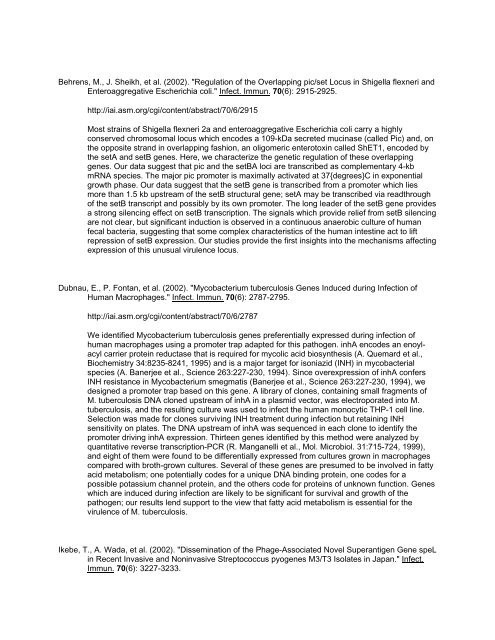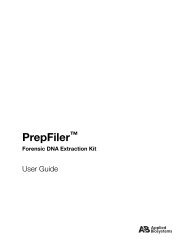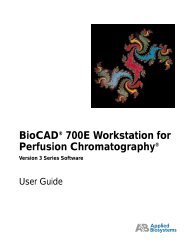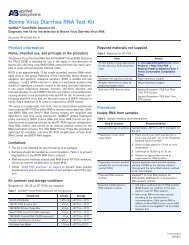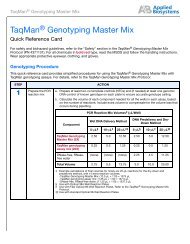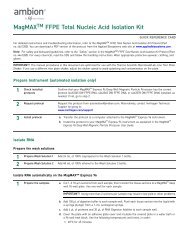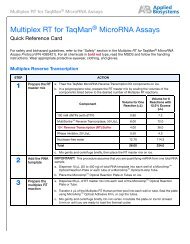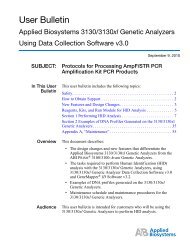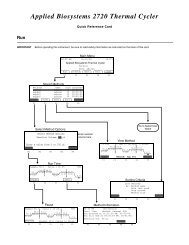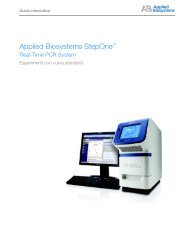AmpliTaq and AmpliTaq Gold DNA Polymerase - Applied Biosystems
AmpliTaq and AmpliTaq Gold DNA Polymerase - Applied Biosystems
AmpliTaq and AmpliTaq Gold DNA Polymerase - Applied Biosystems
You also want an ePaper? Increase the reach of your titles
YUMPU automatically turns print PDFs into web optimized ePapers that Google loves.
Behrens, M., J. Sheikh, et al. (2002). "Regulation of the Overlapping pic/set Locus in Shigella flexneri <strong>and</strong>Enteroaggregative Escherichia coli." Infect. Immun. 70(6): 2915-2925.http://iai.asm.org/cgi/content/abstract/70/6/2915Most strains of Shigella flexneri 2a <strong>and</strong> enteroaggregative Escherichia coli carry a highlyconserved chromosomal locus which encodes a 109-kDa secreted mucinase (called Pic) <strong>and</strong>, onthe opposite str<strong>and</strong> in overlapping fashion, an oligomeric enterotoxin called ShET1, encoded bythe setA <strong>and</strong> setB genes. Here, we characterize the genetic regulation of these overlappinggenes. Our data suggest that pic <strong>and</strong> the setBA loci are transcribed as complementary 4-kbmRNA species. The major pic promoter is maximally activated at 37{degrees}C in exponentialgrowth phase. Our data suggest that the setB gene is transcribed from a promoter which liesmore than 1.5 kb upstream of the setB structural gene; setA may be transcribed via readthroughof the setB transcript <strong>and</strong> possibly by its own promoter. The long leader of the setB gene providesa strong silencing effect on setB transcription. The signals which provide relief from setB silencingare not clear, but significant induction is observed in a continuous anaerobic culture of humanfecal bacteria, suggesting that some complex characteristics of the human intestine act to liftrepression of setB expression. Our studies provide the first insights into the mechanisms affectingexpression of this unusual virulence locus.Dubnau, E., P. Fontan, et al. (2002). "Mycobacterium tuberculosis Genes Induced during Infection ofHuman Macrophages." Infect. Immun. 70(6): 2787-2795.http://iai.asm.org/cgi/content/abstract/70/6/2787We identified Mycobacterium tuberculosis genes preferentially expressed during infection ofhuman macrophages using a promoter trap adapted for this pathogen. inhA encodes an enoylacylcarrier protein reductase that is required for mycolic acid biosynthesis (A. Quemard et al.,Biochemistry 34:8235-8241, 1995) <strong>and</strong> is a major target for isoniazid (INH) in mycobacterialspecies (A. Banerjee et al., Science 263:227-230, 1994). Since overexpression of inhA confersINH resistance in Mycobacterium smegmatis (Banerjee et al., Science 263:227-230, 1994), wedesigned a promoter trap based on this gene. A library of clones, containing small fragments ofM. tuberculosis <strong>DNA</strong> cloned upstream of inhA in a plasmid vector, was electroporated into M.tuberculosis, <strong>and</strong> the resulting culture was used to infect the human monocytic THP-1 cell line.Selection was made for clones surviving INH treatment during infection but retaining INHsensitivity on plates. The <strong>DNA</strong> upstream of inhA was sequenced in each clone to identify thepromoter driving inhA expression. Thirteen genes identified by this method were analyzed byquantitative reverse transcription-PCR (R. Manganelli et al., Mol. Microbiol. 31:715-724, 1999),<strong>and</strong> eight of them were found to be differentially expressed from cultures grown in macrophagescompared with broth-grown cultures. Several of these genes are presumed to be involved in fattyacid metabolism; one potentially codes for a unique <strong>DNA</strong> binding protein, one codes for apossible potassium channel protein, <strong>and</strong> the others code for proteins of unknown function. Geneswhich are induced during infection are likely to be significant for survival <strong>and</strong> growth of thepathogen; our results lend support to the view that fatty acid metabolism is essential for thevirulence of M. tuberculosis.Ikebe, T., A. Wada, et al. (2002). "Dissemination of the Phage-Associated Novel Superantigen Gene speLin Recent Invasive <strong>and</strong> Noninvasive Streptococcus pyogenes M3/T3 Isolates in Japan." Infect.Immun. 70(6): 3227-3233.


